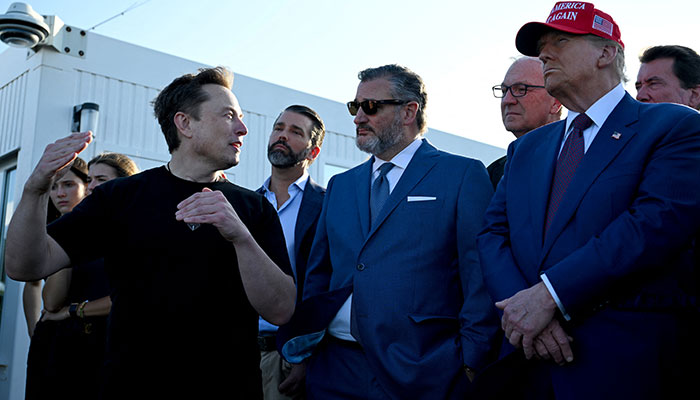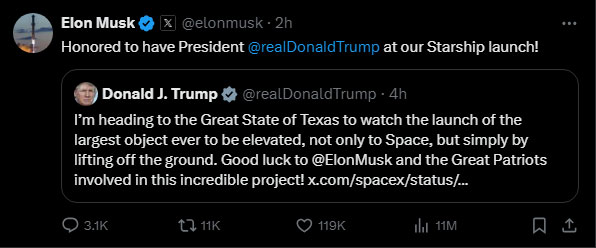
US President-elect Donald Trump personally watched Elon Musk’s SpaceX launch its sixth Starship test flight into space on Tuesday from Texas, where the company aims to implement various improvements to the rocket.
The nearly 400-foot (122-meter) rocket system, designed to land astronauts on the moon and ferry crews to Mars, lifted off at 4 p.m. Central Time (2200 GMT) from SpaceX’s sprawling rocket development site in Boca Chica. Texas.
The first stage, called Super Heavy, unexpectedly landed in the Gulf of Mexico instead of trying to return to the launch pad, indicating something had gone wrong.
In space, the spacecraft will travel around Earth on a planned day trip into the Indian Ocean in about 90 minutes.
Last month, the spacecraft demonstrated the new landing method for the first time, achieving a major milestone in its reusable design. Musk wrote on social media before the launch that Tuesday’s landing was expected to be “faster and harder.”
Trump’s presence indicates a deep alliance with Musk, who will benefit from Trump’s election victory, as the billionaire businessman is expected to have extraordinary influence to help his companies and secure preferential government treatment.
Musk, the world’s richest person, has been a prominent supporter of Trump’s presidential campaign, appearing with him at rallies and backing him with at least $119 million in political support.
“I am heading to the great state of Texas to witness the launch of the largest object ever lifted, not just into space, but simply by levitating off the Earth,” Trump wrote on social media, wishing Musk good luck with the launch. .

Trump on November 13 appointed Musk as co-leader of a new government efficiency project that the SpaceX founder and Tesla CEO said would rid the federal government of wasteful spending and regulation that he described as burdensome.
The US Federal Aviation Administration’s regulation of commercial rocket launches has been a source of frustration for Musk, who has complained that the agency is hampering his company’s progress on reaching Mars.
But the Federal Aviation Administration’s approval of the spacecraft’s launch license on Tuesday just over a month after the rocket’s previous flight was the fastest regulatory shift yet for SpaceX, as the agency develops new launch approval processes aimed at keeping pace with the growth of the U.S. space industry.
Musk on Tuesday listed four primary goals for the test flight – restarting the spacecraft’s specially designed engine for space during flight – which is key to its ability to maneuver in space – and making the landing more visible in the ocean during the day, whereas previous attempts were at night.
“There are thousands of small design changes being tested as well,” Musk said.
SpaceX is looking to make rapid progress in spacecraft development during the second Trump administration. The administration’s space agenda is expected to give NASA’s Artemis program, which is set to return astronauts to the surface of the moon, greater focus on the more ambitious goal of landing people on Mars, Musk’s main ambition in space.
“We just went through 400 Falcon launches, and I wouldn’t be surprised if we launch 400 spacecraft in the next four years,” Gwen Shotwell, SpaceX’s president and chief operating officer, said at the Barron’s Investment Conference in New York last week. Company plans. Spine rocket.
